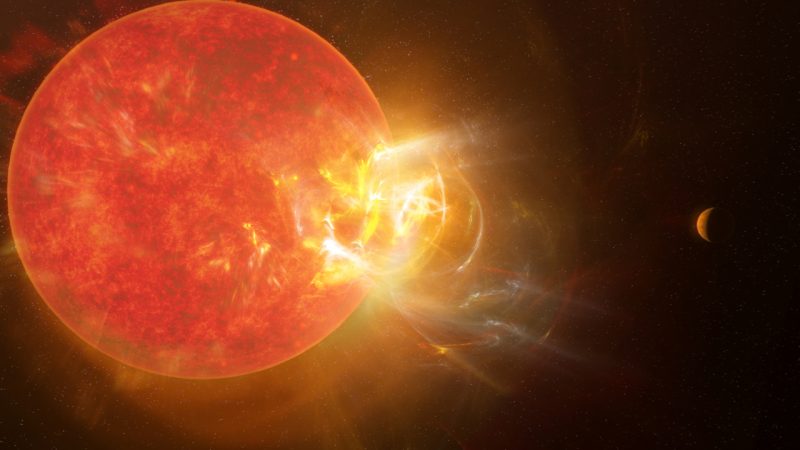
As the current sunspot cycle (Cycle 25) revs up, we can expect our sun to become more active in the coming few years. And that means more solar flares, or bursts of radiation on our sun. But the flares on our sun can’t compare to those on the next-nearest star, Proxima Centauri. Astronomers said on April 21, 2021, they spotted a flare, or burst of radiation, from Proxima that’s 100 times more powerful than any flare seen coming from our sun. They said the flare ranks as one of the most violent seen on a solitary star anywhere in the galaxy. Little Proxima is a faint red dwarf star. It’s usually considered to be part of the star system Alpha Centauri and is only 4.2 light-years away. Since red dwarfs are common and tend to have mighty flares – and since the flares might (or might not) adversely affect the chances of life forming on planets orbiting red dwarfs – these astronomers said their study might help shape the hunt for life beyond our solar system.
The peer-reviewed Astrophysical Journal Letters published this new study on April 21. Astrophysicist Meredith MacGregor of the University of Colorado-Boulder led the research, in which astronomers observed Proxima for 40 hours in 2019, using nine telescopes on the ground and in space. MacGregor said that Proxima:
… went from normal to 14,000 times brighter when seen in ultraviolet wavelengths over the span of a few seconds.
Proxima’s powerful flare was seen across the entire electromagnetic spectrum. The astronomers said this is the first time that a single stellar flare, other than those that occur on the sun, has been observed with such complete wavelength coverage. MacGregor said:
We had never seen an M dwarf flare at millimeter wavelengths before 2018, so it was not known whether there was corresponding emission at other wavelengths.
The study was precipitated by the serendipitous discovery of a flare from Proxima Centauri in 2018 archival data from the Atacama Large Millimeter/submillimeter Array (ALMA), a linked array of 66 radio telescopes in northern Chile. Afterwards, MacGregor’s team coordinated an effort to observe Proxima, using the ALMA telescope and other telescopes on Earth and in space. In May 2019, the effort paid off, when Proxima Centauri ejected its violent flare, which lasted just seven seconds, but generated a surge in both ultraviolet and millimeter wavelengths. The flare was characterized by a strong, impulsive spike never before seen at these wavelengths. The event was recorded by five of the nine telescopes involved in the study, including the Hubble Space Telescope (HST) in ultraviolet, and ALMA in millimeter wavelengths.

Powerful flares from our sun may happen only a few times in an 11-year solar cycle. MacGregor compared the flares on Proxima Centauri, saying:
Proxima Centauri’s planets are getting hit by something like this not once in a century, but at least once a day, if not several times a day.
She added:
If there was life on the planet nearest to Proxima Centauri, it would have to look very different than anything on Earth. A human being on this planet would have a bad time.
Bottom line: Astronomers saw Proxima Centauri – the star nearest our sun – emit a powerful flare, or burst of radiation, in May 2019. Proxima’s flare was 100 times more powerful than our sun’s flares. They said Proxima’s flare ranks as one of the most violent seen on a solitary star anywhere in the galaxy.











